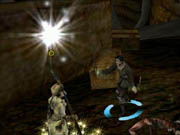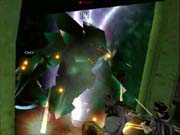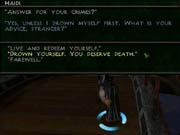You may already be familiar with Volition's Summoner, which originally debuted on the PlayStation 2 console, from the hilarious

Summoner is a fully 3D role-playing game; just about everything in the game, from its well-animated characters to each of its huge areas, is rendered in true 3D. Unfortunately, not all of Summoner's graphics are terribly detailed; certain of the game's environments use simple, repetitive textures that look washed out and blotchy at some points. In addition, many of Summoner's larger areas suffer from rather obvious draw-in that's poorly hidden by fog. But the game's powerful graphics engine also allows for some of the biggest, most colorful, and most picturesque vistas ever to appear in a 3D role-playing game. Summoner's enormous towers, throne rooms, and chapels compare favorably with the best environments in other graphically impressive role-playing games like Vampire and EverQuest. Summoner also features excellent special effects: As your characters grow more powerful and learn more magic spells, they'll be able to create blazing walls of fire and bolts of white-hot lightning. And though you may find it strange that each of the game's characters has pale, gray skin, you'll definitely appreciate your characters' fluid movements, expressive facial animation, and wide variety of weapons and armor--items that all appear on the actual character models when equipped.

However, even though the game's 3D graphics generally look impressive, they present a number of problems that tend to detract significantly from Summoner's gameplay. Specifically, the game's 3D camera is completely inadequate, even though it's clear that the developers tried to make the camera work well. Summoner lets you change from a behind-the-back third-person perspective to an overhead perspective, rotate the camera, and zoom in and out slightly. Unfortunately, these options just don't seem sufficient in practice. For instance, unlike the console version, which lets you freely move your character using an analog stick, Summoner only lets you move by pointing and clicking, as in Blizzard's action role-playing game, Diablo. But Summoner's restrictive top-down view doesn't let you see far enough into the distance to spot important landmarks or wandering enemies, and in the behind-the-back perspective, your characters and any nearby scenery or objects will tend to obstruct your movement so that instead of clicking to a point ahead of you, you'll often end up clicking on and selecting one of your characters instead. This becomes especially frustrating in both cramped dungeon areas and areas with varying heights. In either case, you won't be able to get a good look at your characters in action, since you won't be able to see them behind a wall or above the curve of a hill. The camera does cut away some barriers; that is, it makes them transparent as you move in front of them. But for every town building that conveniently cuts away, Summoner has a thick dungeon wall or winding cavern that doesn't. What's more, Summoner's camera isn't entirely under your control; at times, it will automatically rotate to center your characters onscreen and will occasionally rotate continuously unless you move your character. These problems can make combat needlessly frustrating. And because of these camera problems, and the general size of most of Summoner's areas, it's easy to get lost even with the in-game map--especially considering that the map itself takes up half of the screen and restricts your immediate field of vision even further.

Summoner's camera problems wouldn't be so frustrating if they didn't interfere with combat. Summoner has an unusual and complex combat system that borrows heavily from Square's console RPG, Vagrant Story. Though you can gather a party of up to five characters, Summoner only lets you control a single one at a time. In combat, your active character may fight enemies with "chain attacks," which are continuous strings of special attacks that must be triggered with the proper timing. Your character's chain attacks, as well as any other special abilities, like casting spells, are limited by its supply of action points; once your character has run out of points, it can't perform a chain attack. Interestingly, Summoner's chain attacks prolong your character's turn in combat; that is, as long as your character is successfully carrying out a continuous chain attack, an attacking enemy can't fight back. And if you use chain attacks regularly, your characters will learn new and more powerful chain-attack maneuvers, like magical life-draining spells or crippling slashes. In addition, Summoner features a tactical combat system that applies bonuses and penalties based on whether your characters are attacking from the rear, flanking an enemy, or are holding the high ground. Furthermore, your characters not only learn new attack skills as they gain levels, they can also develop their combat abilities by spending skill points at each level, as in many PC role-playing games. Finally, though Summoner only lets you control a single character at a time, you can set behavior patterns for your other party members: You can decide whether they'll tend to attack an enemy directly, support their allies, or stay back and cast spells; however, these artificial intelligence patterns are inconsistent. At its best, Summoner's combat system is surprisingly enjoyable, as it lets you take full strategic advantage of your surroundings and your party's abilities. At its worst, your carefully prepared trap will fall to pieces the moment you try to maneuver your lead character in place, only to have your sight blocked by an opaque wall or when one of your other characters decides to move without your orders, which may cause the camera to automatically rotate the screen and throw off the placement of your characters as well as the timing of your chain attack.
Despite its other problems, Summoner has an excellent story. Though its basic premise of a young peasant boy being a prophesied savior is thoroughly cliché, the actual storyline is superb, fraught with treachery and genuinely surprising twists and turns, and is interesting enough to provide incentive to continue through the game's sometimes frustrating combat areas and quests. Over the course of his adventures, the game's protagonist, Joseph meets with three other companions: Flece, the thief; Rosalind, the wizard-monk; and Jekhar, the soldier. Each character has its own motives, and each views Joseph differently. The game's player characters and nonplayer characters are all made interesting because of Summoner's generally good writing and solid voice-acting; voiceover is only provided in the game's in-engine cutscenes, though it's generally quite good.

Summoner also lets you completely ignore the story by playing the game in multiplayer mode on THQ's recently launched online game service, www.thqmultiplay.net. In this mode, you can play through each of Summoner's main areas as Joseph, Flece, Rosalind, or Jekhar. Summoner's multiplayer mode replaces all nonplayer characters with hostile enemies that you can fight to gain levels and earn loot. This hack-and-slash multiplayer mode is reminiscent of Diablo in that you can create an account, then you create a character to play in online games that you or other players create and join. Though Summoner's multiplayer mode doesn't randomly generate maps (as Diablo and Diablo II do), and it doesn't feature anywhere near as many items as Diablo, it's still enjoyable enough, as it lets you make more use of your character's skills and chain attacks without having to worry about babysitting unpredictable party members. And during peak hours, you can actually find plenty of games to join.
Summoner is the result of a lot of ambitious plans; plans to combine console and PC role-playing conventions; plans to make an enjoyable single- and multiplayer game; and plans to make a fully 3D role-playing game with huge environments displayed with an intelligent 3D camera. Unfortunately, not all of these plans succeeded. Many of Summoner's flaws, like its inadequate camera options, its unreliable party-member AI, and its bland, ambient music become apparent within the first few hours of play. However, if you can tolerate its problems, you'll find that Summoner is a game of hidden depth; a game with an interesting combat system, an intriguing story, and an enjoyable multiplayer mode to boot.